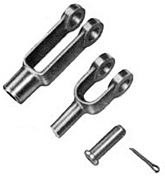
Yoke ends are commonly used in conjunction with a cable or rod to lift heavy objects. These U-shaped fasteners come with clevis and clotter pin. The clevis is inserted through the holes of a yoke end, after which it’s secured with the clotter pin. This simple design makes yoke ends a popular fastening mechanism for lifting applications. With that said, there are several things you should know about yoke ends. This post offers a beginner’s guide to yoke ends.
Overview of Yoke Ends
Also known as clevis ends, yoke ends are U-shaped fasteners that are designed to secure cables or rods. As previously mentioned, they are commonly used in lifting applications. A cable or rod can be inserted through the opening of a yoke end, after which it can be used to lift an object.
Many yoke ends are threaded. They have a U-shaped opening on one end. On the other end is a threaded hole. The threaded hole, of course, supports other threaded fasteners.
Yoke ends typically require the use of a clevis and clotter pin. The clevis is an untreated rod, whereas the clotter pin is a thin metal pin. These are used together to secure the open end of a yoke end. Without a clevis and clotter pin, the yoke end will be open. As a result, it won’t be able to hold a rod or cable, nor will be able to lift the objects to which they are connected. The clevis and clotter pin essentially closes the yoke end while securing the rod or cable in place.
How to Choose Yoke Ends
You can find yoke ends in different materials. Stainless steel is a popular material in which yoke ends are made. Stainless steel yoke ends offer a high level of protection against corrosion, allowing them to withstand moist and humid environments. You can also find yoke ends made of carbon steel. Carbon steel is stronger than stainless steel, but it doesn’t offer the same high level of protection against corrosion. Rather, carbon steel is more susceptible to corrosion due to its lack of chromium.
When choosing yoke ends, pay attention to the size. Yoke ends are available in a variety of sizes. Some of them are longer than others, and some of them have a wider opening than others. You should choose yoke ends in the right size for your application.
You should also consider whether or not the clevis and clotter pin are included with a yoke end. Most yoke ends will, in fact, include these fasteners. Some stores, however, sell the clevis and clotter pins separately.
